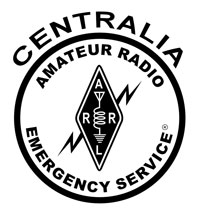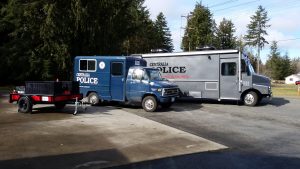
The large Command Van, designated “Comm I” by the Amateur Radio Emergency Services team, is primarily used by police and fire as an on scene command vehicle when staff need a place out of the rain to conduct business. It includes four independent seating areas with computer plug ins and law/fire radios. One VHF amateur radio is located in the first seat by the printer. This vehicle was a former tool truck converted with a drug seizure grant.
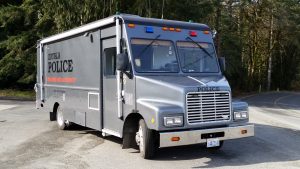
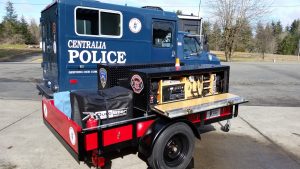
The blue communications vehicle, designated “Comm II” is assigned to the Amateur Radio Emergency Services team. It was a military flight line
equipment truck in a former life until ownership changed to the City of Centralia. ARES volunteers spent their own money and time to convert the vehicle for emergency communications use. Currently, it has more communications capability than any other vehicle in Lewis County. Designed with three operating positions (plus two in the cab if needed), it carries VHF, UHF, HF, digital, Fire / Law radio systems and a CB radio. Comm II is used as a primary command and control vehicle for the ARES team and could function, if necessary, as a mobile Emergency Operations Center (EOC) capable of establishing a communications link with the Washington State ECO at Camp Murray.
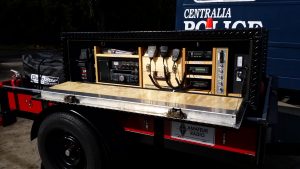
The small communications trailer, designed “Comm III” was constructed by the ARES team. A stand alone communications vehicle in its own right, this trailer has a full array of comms gear which includes UHF, VHF, HF and Law/fire radios. Powered by shore power, battery, generator or solar systems, it was designed to provide emergency communications at a shelter or disaster scene. A 10′ x 10′ tent provides shelter when necessary. The vehicles communication box also contains a removable VHF/UHF radio system that can be taken into a shelter to establish a communications link with the Centralia Emergency Operations Center or the Riverside Fire Authority Emergency Coordination Center (ECC).
The City of Centralia, though small by many city standards, has experienced just about every disaster short of a full blown Tornado. During floods and after a large earthquake, the community may become four independent response areas as damaged bridges or demolished overpasses block normal transportation routes. The three communications vehicles shown here, then become vital as independent “command and control” centers in isolated districts.

